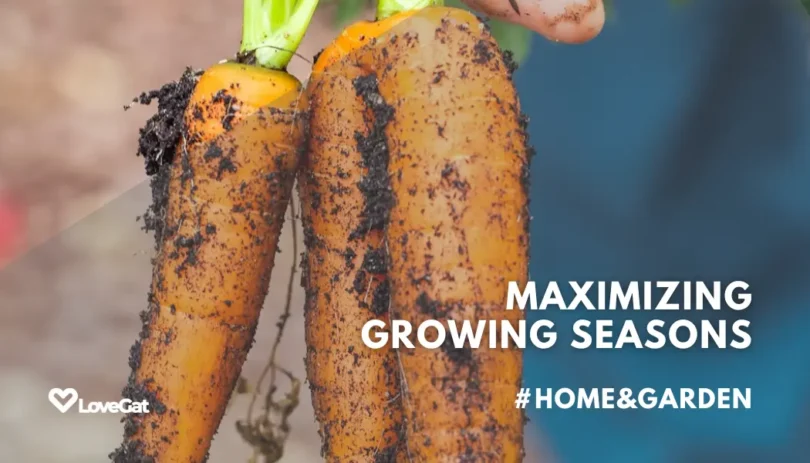Maximizing Your Growing Season and Extending Harvest Times!
Gardening enthusiasts are always seeking innovative ways to extend their growing seasons and prolong their harvests, allowing them to enjoy a bounty of fresh produce for an extended period. In this extensive guide, we’ll delve into a plethora of techniques and strategies that can help you maximize your garden’s potential, prolong your harvest times, and make the most of every growing season.
1. Start Early with Indoor Seed Starting
Kickstart your growing season by starting seeds indoors several weeks before the last frost date in your area. Indoor seed starting allows you to nurture seedlings in a controlled environment, providing optimal conditions for germination and early growth. To get started, gather seed trays or containers filled with nutrient-rich seed starting mix, sow seeds according to packet instructions, and provide adequate lighting with grow lights or a sunny windowsill. By starting seeds indoors, you can get a head start on the growing season and transplant healthy seedlings into the garden once the weather warms up.
2. Utilize Cold Frames and Row Covers
Extend your growing season into the colder months by utilizing cold frames and row covers to protect your plants from frost and harsh weather conditions. Cold frames are simple structures with transparent covers that create a mini-greenhouse environment, trapping heat and providing insulation for tender plants. Row covers are lightweight fabrics that can be draped over garden beds to shield plants from frost, wind, and pests while still allowing sunlight and air to penetrate. By incorporating these protective structures into your garden, you can create microclimates that promote healthy growth and prolong the harvest.
3. Experiment with Season Extension Techniques
Explore a variety of season extension techniques, including hoop houses, high tunnels, and low tunnels, to create protected environments for your plants. Hoop houses and high tunnels are larger structures made from arched frames covered with greenhouse-grade plastic or fabric, providing ample space for growing crops throughout the year. Low tunnels are smaller structures consisting of hoops or arches covered with row cover fabric, ideal for protecting individual rows or beds from frost and cold temperatures. By experimenting with different season extension techniques, you can tailor your approach to suit your garden’s specific needs and climate conditions.
4. Grow Cold-Hardy and Frost-Tolerant Crops
Select cold-hardy and frost-tolerant crops that can withstand cooler temperatures and continue producing well into the fall and winter months. Cold-hardy vegetables such as kale, spinach, carrots, radishes, and Brussels sprouts are capable of thriving in chilly conditions and can even improve in flavor after exposure to frost. By incorporating these resilient crops into your garden, you can extend your harvest and enjoy fresh produce long after the traditional growing season has ended.
5. Implement success-planting strategies.
Maximize your garden’s productivity by implementing succession planting strategies that ensure a continuous supply of fresh produce throughout the growing season. Succession planting involves sowing seeds or transplanting seedlings in staggered intervals, allowing you to harvest crops at different stages of maturity. As one crop is harvested, replant the same area with a quick-growing crop or a different variety to fill the space and maintain a steady harvest. By carefully planning your succession plantings, you can make the most of your garden space and prolong the harvest.
6. Extend the Harvest with Crop Protection
Protect your crops from early frosts and inclement weather by utilizing crop protection measures such as blankets, tarps, and floating row covers. These protective coverings create a barrier against frost and wind while trapping heat and moisture around the plants, creating a favorable microclimate for growth. Be sure to anchor the covers securely to prevent them from blowing away in strong winds and remove them during the day to allow sunlight to reach the plants. By extending the harvest with crop protection, you can safeguard your crops and prolong the growing season.
By incorporating these techniques and strategies into your gardening practices, you can extend your growing season, prolong your harvest times, and enjoy a bountiful supply of fresh produce throughout the year. Whether you’re starting seeds indoors, utilizing season extension structures, or practicing succession planting, there are numerous ways to maximize your garden’s potential and reap the rewards of an extended growing season. Experiment with different methods, adapt to your local climate and growing conditions, and enjoy the satisfaction of harvesting homegrown produce well beyond the typical growing season. Happy gardening!
You Might Also Like
- How I used AI to create a living data visualization for our home
- 20 Cool Home Decor And Designs For Any Style
- Planning a garden? Here’s a step-by-step guide to starting off on the right foot
Social Media Communities
Share your digital nomad experiences and connect with fellow Us:
- Instagram: @Lovegatofficial
- Facebook: @LoveGat
Your journey doesn’t end here. Continue to explore and share our Decor & Home Posts.







